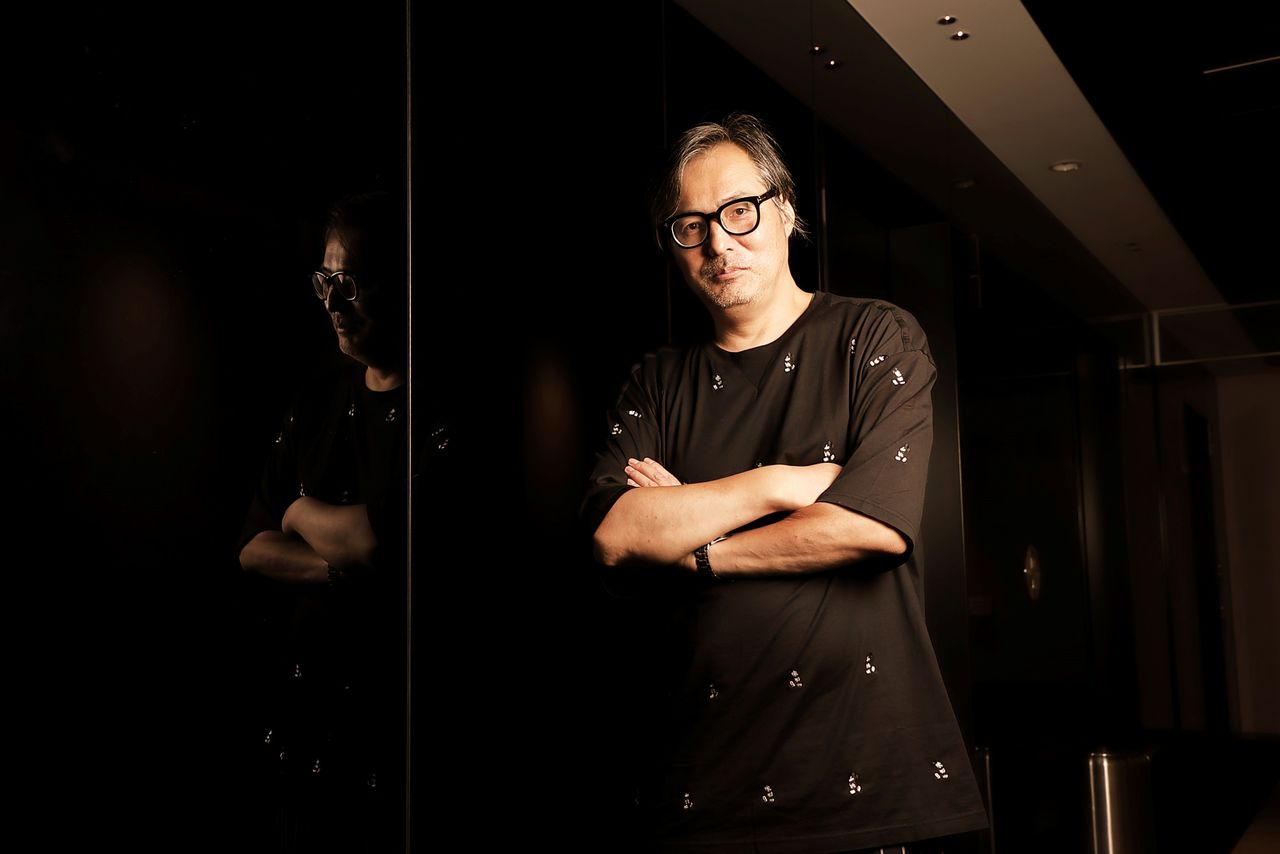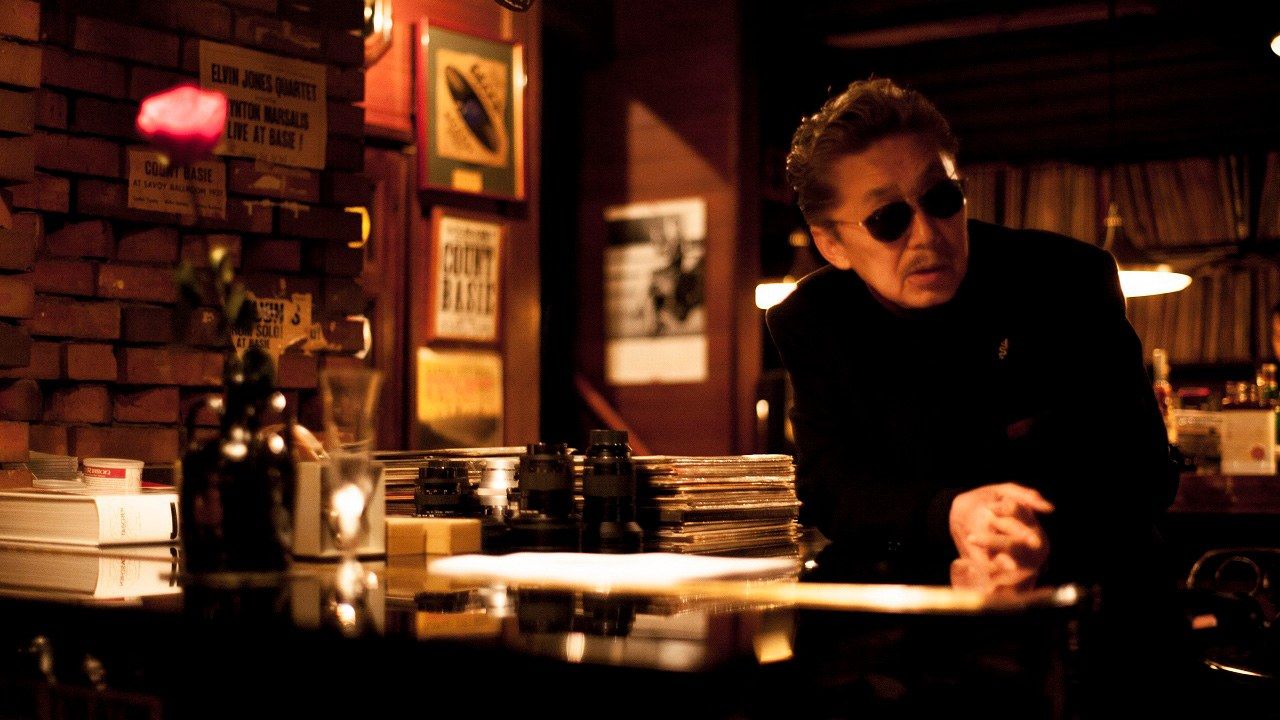
A Legendary Jazz Café Brought to the Screen
Culture Entertainment Music- English
- 日本語
- 简体字
- 繁體字
- Français
- Español
- العربية
- Русский
A Journey to Basie
The jazz café, or jazu kissa, is a unique genre of music venue that evolved in Japan as a place where aficionados gather to listen not to live music but to recorded jazz, in acoustic settings that are as close to ideal as possible. Born in the 1950s, these kissa flourished in the following decade and were everywhere in Japanese cities by the end of the 1960s. Although the golden age of the jazz café faded in the decades that followed, and many classic examples closed, others sprang up to take their place, and there are still around 600 dedicated jazz kissa in business around the country today.
Of all the classics that survive around the country, Basie is special: a legendary venue spoken of in hushed, reverent tones among jazz fans for the unrivaled acoustic experience it offers. Owner Sugawara Seiji started the business in Ichinoseki, Iwate Prefecture, in 1970 after graduating from Waseda University, where he been a member of a big band called the High Society Orchestra. In 1970, he returned to his Iwate hometown and converted an earthen warehouse on the grounds of the family home into a new jazz kissa. The name was inspired by Count Basie (1904–84), the legendary piano player and leader of one of the great bands of the big band era.
The trailer for Hoshino Tetsuya’s 2020 Jazu kissa Beishī: Swifty no tanshi (Jazz Café Basie: The Ballad of Swifty).
This world-renowned musician himself heard a rumor about a café with his name in a remote part of Japan. Intrigued, he decided he had to visit and see it for himself. But surely the name alone wouldn’t have been enough to tempt Basie all the way to this provincial city more than 400 kilometers north of Tokyo. Like so many others, Basie was drawn by rumors of the venue’s legendary sound. It was Count Basie himself who gave Sugawara his nickname: “Swifty.”
And now the famous venue has celebrated 50 years since it first opened its doors. Hoshino Tetsuya, director of the film Jazu kissa Beishī: Swifty no tanshi (Jazz Café Basie: The Ballad of Swifty), documenting the iconic location, said he wanted to create a lasting record before it was too late: “You can’t pretend it’s going to be there forever. I wanted to create a record that will live on into the future.
“My first priority was to capture the sound. I was determined to leave a record of Basie’s acoustics for future generations. Everything started from the idea of capturing the sound. That turned out to be a lot of hard work, but the sound team worked hard to capture the real thing. They didn’t want to fob people off with something fake.”
Hoshino wanted to give audience an opportunity to experience the sound produced by the remarkable audio system Sugawara has lovingly put together over the years. This passion for the details of sound comes over in the very first moments of the film. The audience is confronted with a blank screen, over which comes . . . not jazz, but the clattering sound of a steam train clattering relentlessly down the tracks in the middle of a violent thunderstorm, from a documentary recording made in Mississippi in 1961. Hoshino played a copy of the recording over Basie’s equipment and captured it with a vintage microphone.
“The main objective was to get audiences to understand right from the start the volume that Basie’s system can produce. It’s a big, loud sound—but not uncomfortable. The acoustics of the room make it a pleasant sound to listen to. I didn’t want to open with smooth, soothing jazz. I wanted to launch an immediate assault on the audience’s sense of hearing: get people’s auditory attention, right from the outset, without any images at all. Basie is somewhere far away, and the only way to hear this sound is to travel a long way to hear it . . . I wanted the audience to feel this truth for themselves, without needing any tedious explanation. The sound of the steam train carries across time and place. My hope was that the sound would somehow magically transport audiences into the room at Basie’s.”
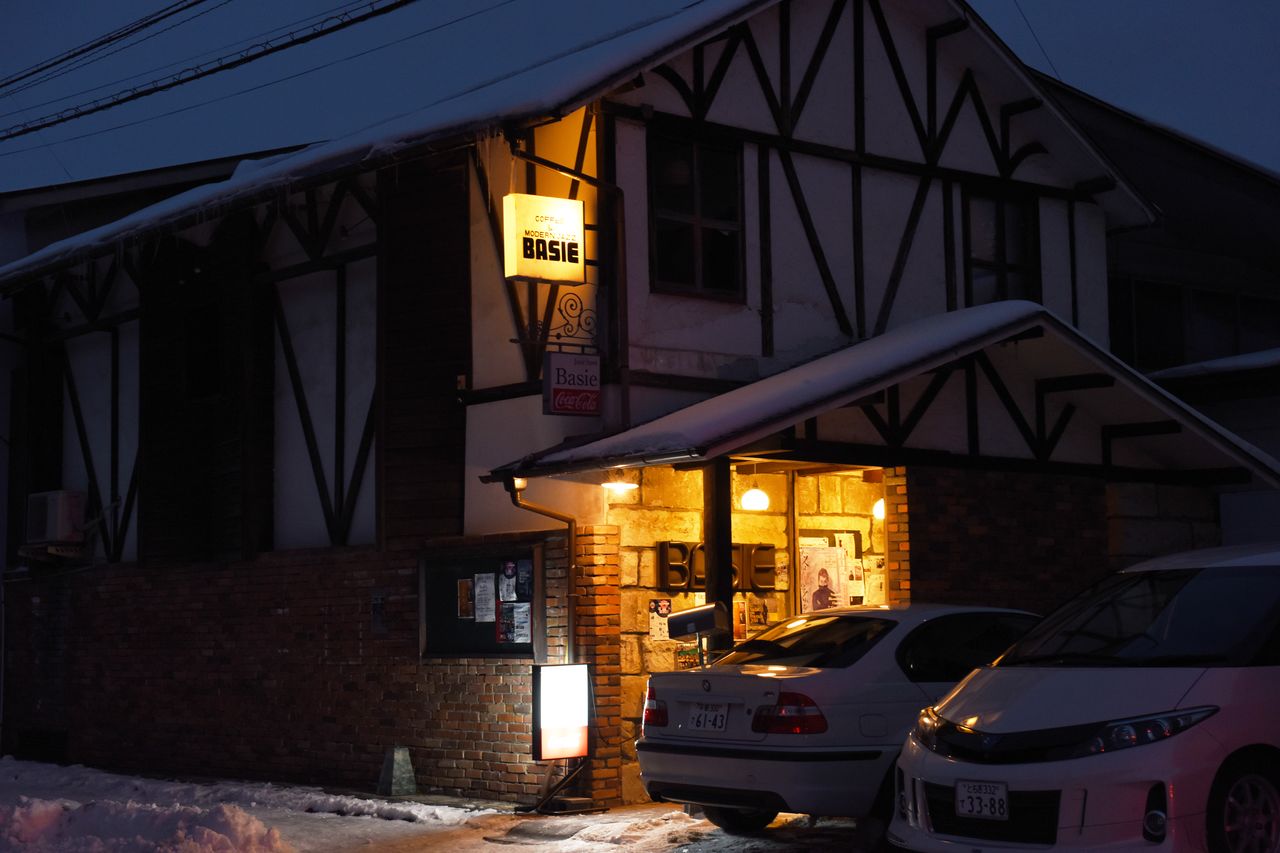
Basie in the snow. (© Jazz Kissa Basie Film Partners)
In Pursuit of the Master
Hoshino says he fell in love with jazz and the world of audio after buying a Miles Davis record as a student in middle school. Although he had been a devoted reader of Sugawara’s columns in the audiophile magazine Stereo Sound since he was a teenager, it wasn’t until he was in his thirties that he set foot in Basie for the first time. Thanks to an introduction from an acquaintance, he was finally able to meet the owner himself.
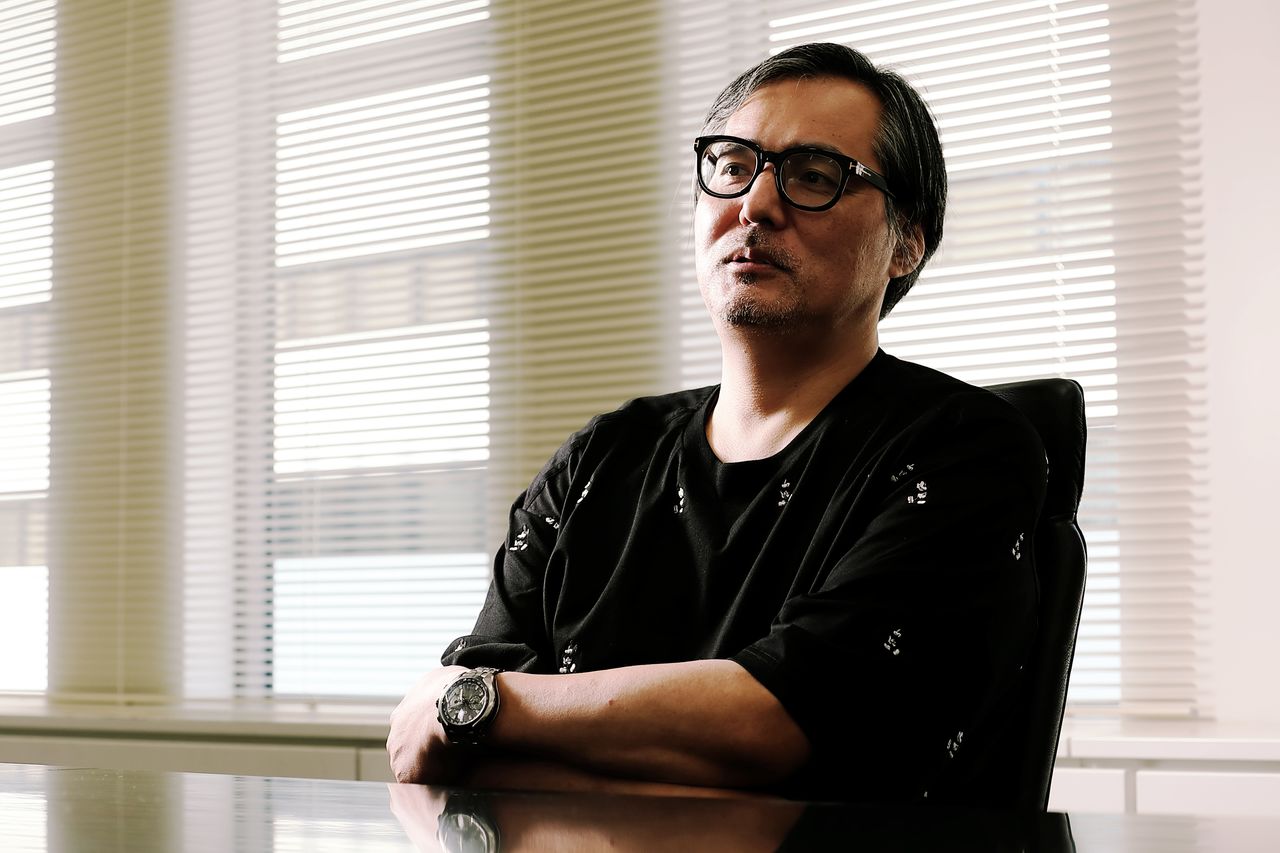
Director Hoshino Tetsuya was born in 1965 in the city of Kitakyūshū, Fukuoka Prefecture. He has managed restaurants and bars since coming to Tokyo in 1986. Jazu kissa Beishī marks his debut as a director.
“For me, Sugawara is a bit like Mt. Fuji, a towering presence. So I knew I couldn’t just approach him casually. He is serious about what he does, and seems to see right through you. I felt a kind of trepidation going into the project. I had always been more into modern jazz, and wasn’t too familiar with the big band era. But when I listened to the music at high volume over the speakers at Basie for the first time, it really knocked me out. It was just this incredibly dense sound. You could hear all the instruments clearly. I’d never heard anything like it. It was a revelation to me that acoustics like this could exist.”
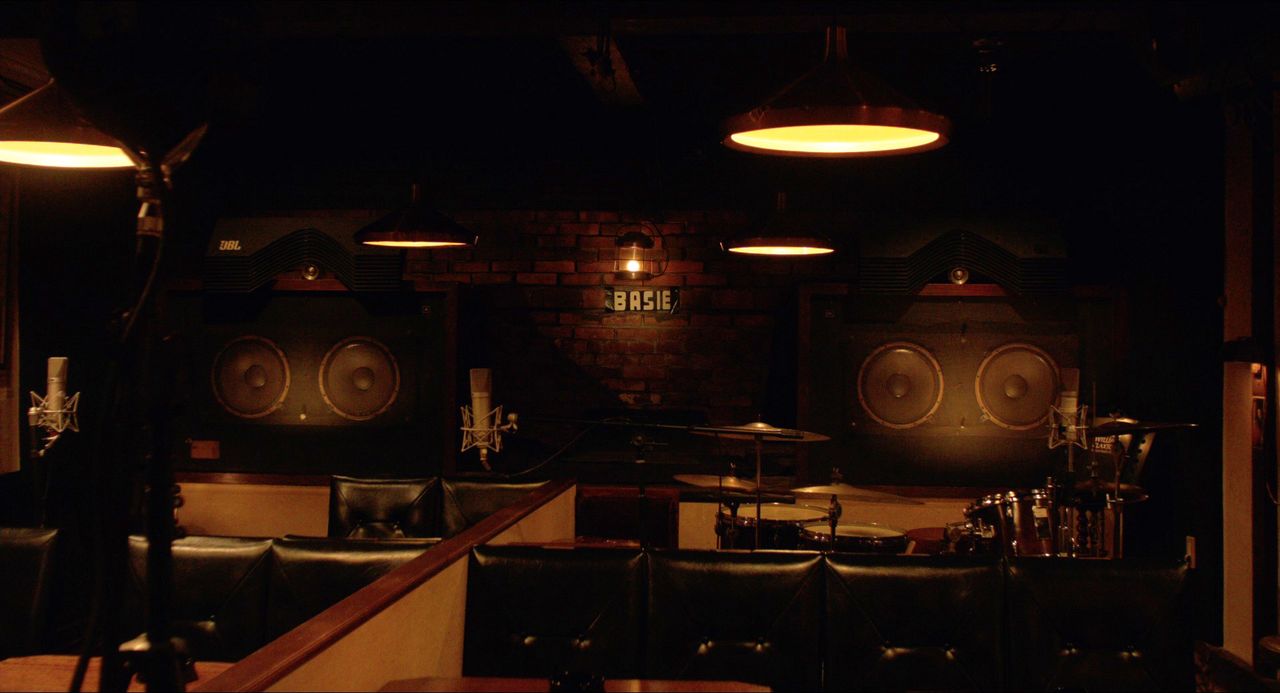
JBL speakers in custom cases dominate the background at Basie. (© Jazz Kissa Basie Film Partners)
Sugawara is more than just an ordinary audiophile nerd. He has a genuine “feel” for sound, as well as a way with words that helps him to express what he feels. He seems to be able to hear the quiet and calm behind this torrential waterfall of sound. And Sugawara thinks nothing of keeping a drum kit on the premises—something that would be anathema for most audiophiles, who tend to shun any extraneous objects that might wreck the venue’s pristine acoustics. Sugawara says a drum kit does nothing to spoil the music: If the cymbals and the skins of the drums—from the lowest to the highest—are in harmony, the kit can even add to the overall experience of the sound. Part of Sugawara’s philosophy seems to be that jazz listened to in sterile silence lacks the same power to touch the heart.
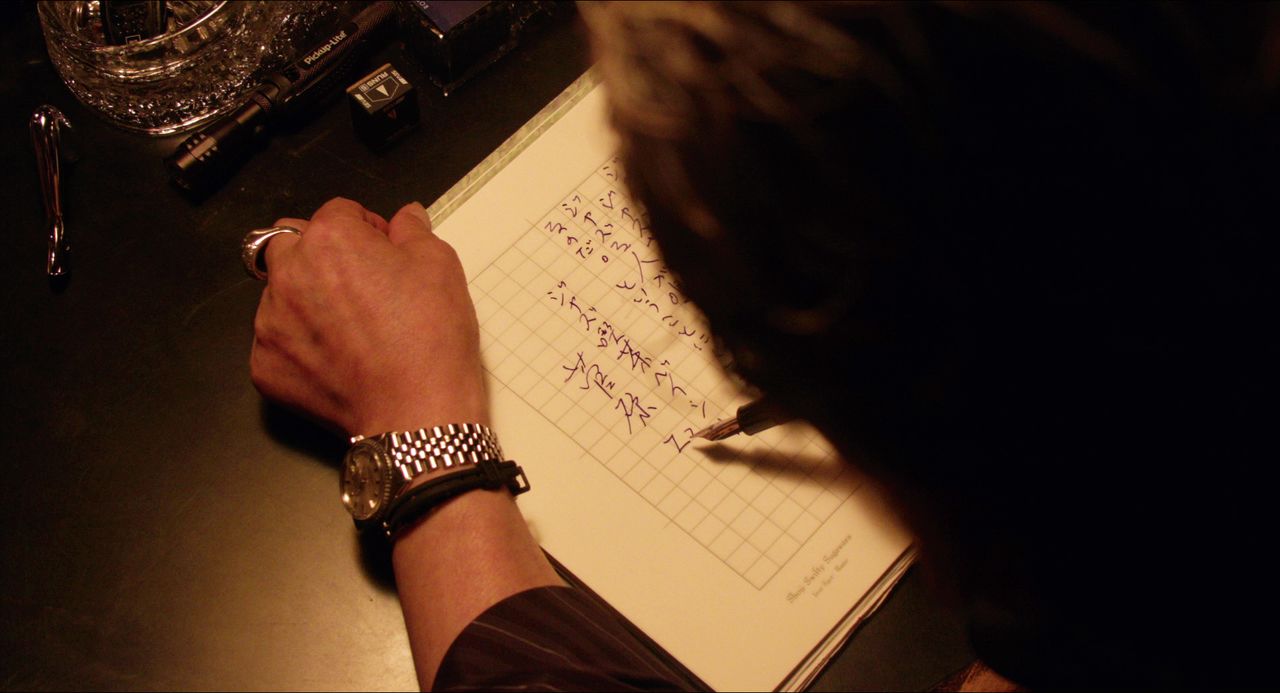
Basie owner Sugawara inks a message: “There’s no such thing as a musical genre called jazz—there are only jazz people.” (© Jazz Kissa Basie Film Partners)
From time to time Sugawara’s offbeat style of conversation produces profundities that seem to hit on the truth of human existence. His essays on audio and jazz are first-rate art criticism, and can even be read as a guide to life.
“My original idea was to get Sugawara-san to talk the way he writes, and to film him speaking in his own words. But it didn’t go to plan. Turns out he’s not someone who will open up if he knows you’re expecting him to talk. It would be at times when I was off my guard and not really expecting anything that he would start to talk seriously about what was on his mind. I tried so many times to get behind the mask. But he saw what I was up to, and always knew what I was trying to get him to say. And then of course he wouldn’t say it!”
Conversation is like jazz: it’s a matter of give and take. And unless the players are in synch, a performance won’t spark and take flight.
“The way he stands and moves when he’s in the café, he’s like a picture. It’s clear that he’s aware of being watched. So as soon as a film crew comes in, he’s immediately on his guard. And the café itself is dead. It’s an environment that needs people and noise before it comes to life: customers at the tables, clouds of cigarette smoke, water boiling in the kitchen, a phone ringing—when all these different elements come together, that’s when Basie really jumps into life. That’s the real Basie.”
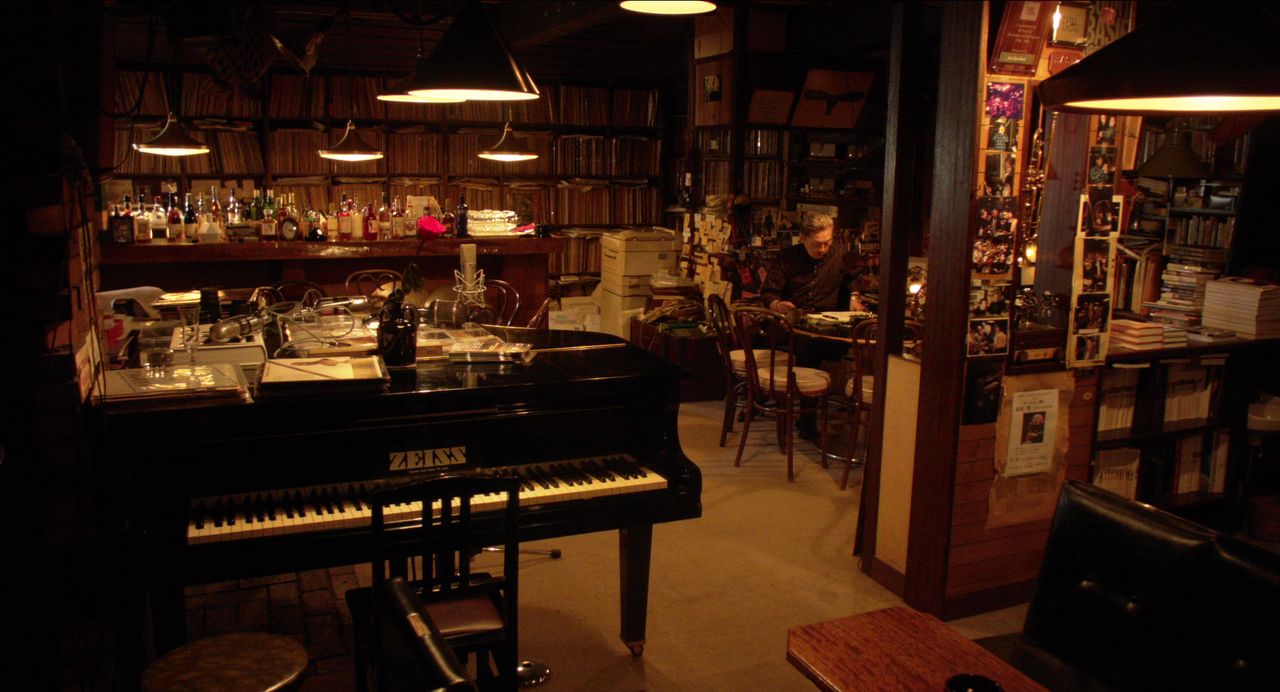
(© Jazz Kissa Basie Film Partners)
At one stage, Hoshino stopping bringing in his full crew of camera, lights, and sound technicians, and took to entering Basie alone with a small compact camera.
“When I started to come in alone, I became part of the scenery, almost like part of the décor or part of the air, he suddenly relaxed and started to speak his mind. But if that was the only footage I had, I would have ended up with little more than a home movie, so the film does make use of footage that was shot with the full crew as well.”
Sometimes Hoshino even recorded Sugawara talking over the phone.
“He would open up a lot over the phone. That’s when he would tell me how much he hates old-fashioned stuff, how much respect he has for hip-hop, things like that. These are things you would never expect to hear from the owner of a jazz kissa. It’s no use just going on about how everything was better in the old days. He sticks with the same equipment that he likes, but that’s because he’s confident that his sound won’t grow old.”
You Have to Feel It
Hoshino delves into the world of music and sound, building a story around Sugawara’s narrative and weaving in stories and anecdotes from the musicians and cultural figures who gather around him. At the same time, he investigates the acoustic secrets of old gramophones and famous Stradivarius violins, and discusses jazz with the world-renowned conductor Ozawa Seiji. As he continues his quest to understand the mysteries of sound wherever they take him, he always comes back to the admiration and amazement he feels for the masters of the form.
“While I was making the film, this quote from Ornette Coleman kept going around my head: that what audiences look for in a jazz musician is a human quality. It made me realize that it’s not just about the sound. That wasn’t enough. I needed to depict the human quality too.”
Of course, scenes featuring footage of important jazz musicians in performance are another attraction of the film. One highlight features precious footage of the avant-garde free jazz alto saxophonist Abe Kaoru playing at Basie not long before his death in 1978, aged just 29. Thanks to a remarkable overlay of sound and image, the young genius seems to fly back down to earth and wander through the crowded streets of modern Shinjuku.
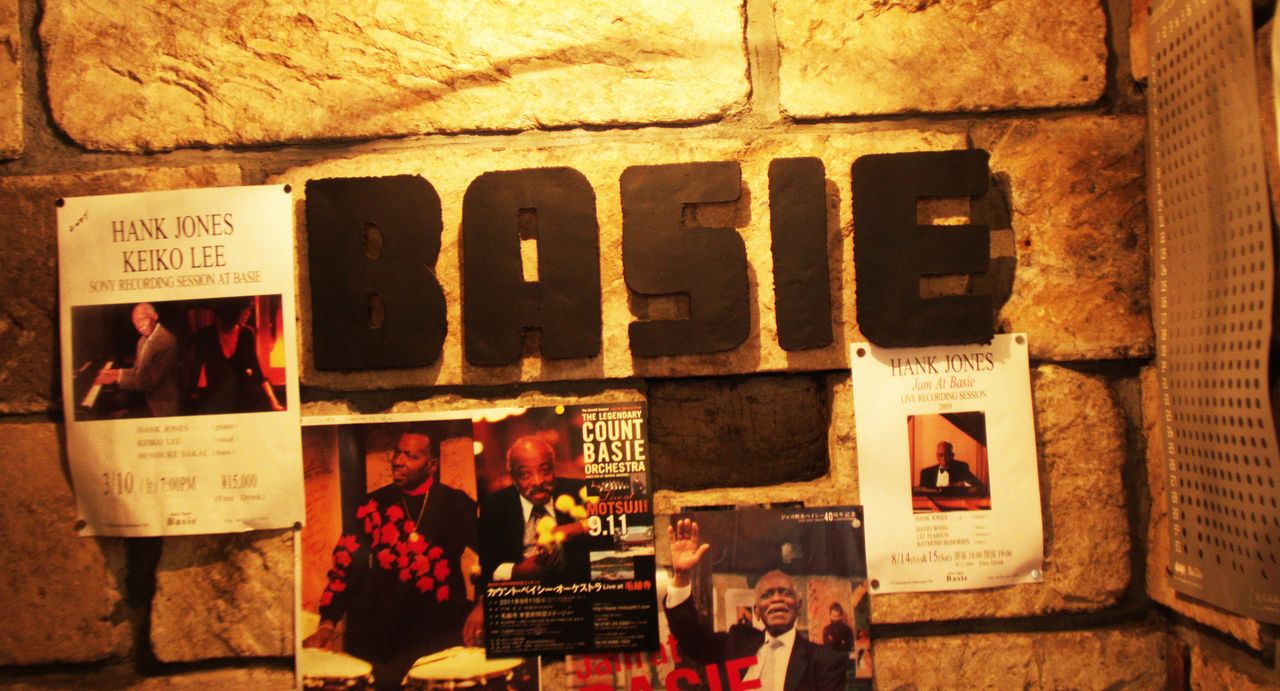
(© Jazz Kissa Basie Film Partners)
Despite Hoshino’s expertise in audio equipment and cameras, his true métier is the hospitality business. He runs a bar himself, and has spent many years rubbing shoulders with the most influential denizens of nighttime Tokyo.
“I never imagined myself directing a film. It was thanks to the support of so many people that we managed to get the film completed in this way. Sugawara himself says in the film that he owes a debt of gratitude to all kinds of people. It made me realize that it was not about him alone. He was not some lofty individual up on a mountain peak doing everything himself. He always says that there’s nothing special about him, just for having gathered all this equipment together and playing the records. What’s important are the musicians’ performances. That’s what makes this incredible sound. And not only that—it’s thanks to all the people who made the records that we are able to listen to this music. From the people who cut the records down to the guy who slipped the record into its sleeve.”
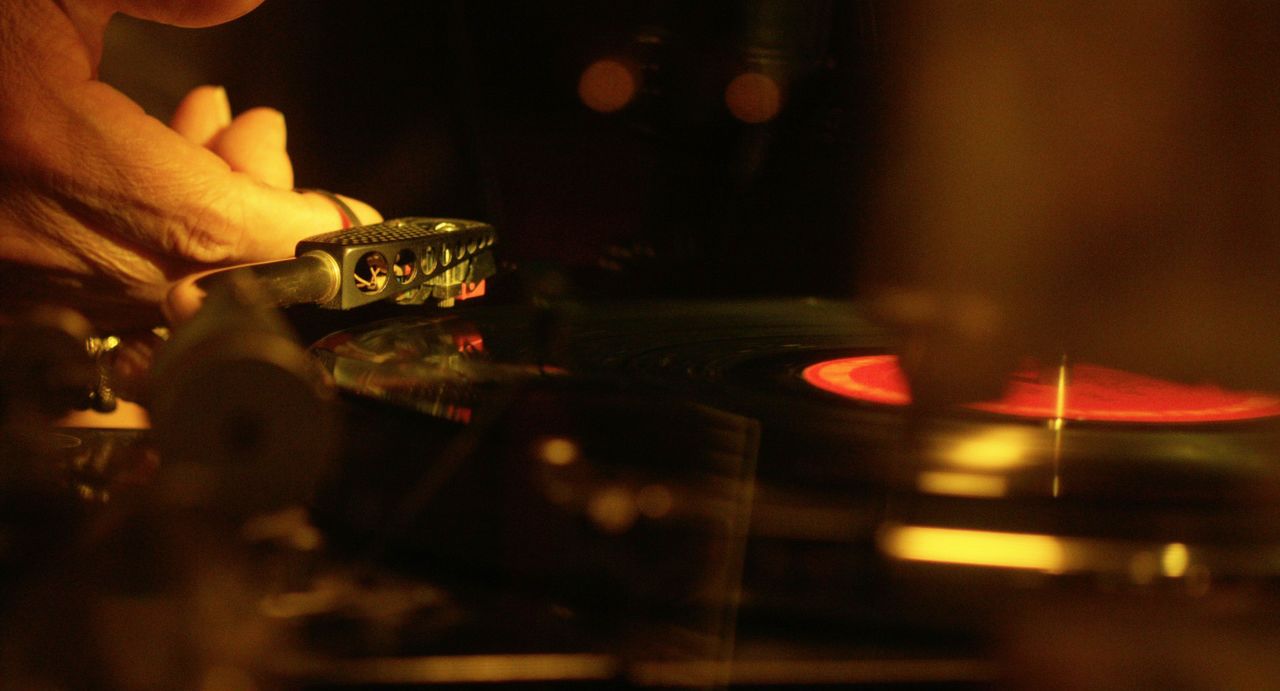
(© Jazz Kissa Basie Film Partners)
And this is perhaps why Sugawara loathes the modern tendency to use the wispy, mellow sounds of soft jazz as background music, and why he continues to pursue the idea of being there in the moment, of capturing the transcendent magic of live performance.
Recent years have hardly been a golden age for jazz as an art form, but Hoshino says a recent episode gave him hope. It took place at Blue Note Tokyo, the famous jazz club in Minami Aoyama, during an event to mark the launch of a jazz-themed manga, Blue Giant, written by Ishizuka Shin’ichi.
“The event opened with a high-school band who had won the audition, and everyone in the audience was really young. They were so passionate, and I felt really moved. ‘Finally,’ I thought, ‘the day has come.’ These kids were taking over. In the past, there had always been this kind of stuck-up atmosphere around jazz—basically, lots of snobby old guys acting as if they owned the music. It made jazz seem unapproachable, inaccessible for a lot of younger people. But I always feel that as long as young people are interested in jazz, those doors can still remain open. Today, I think too often convenience tends to be prioritized above everything else. It’s important to be interested in things, to feel moved by things. To find something you are passionate about and stick with it, to get serious about it and do it the best you can. To be truly moved by something from the bottom of your heart. I hope I managed to get something of that into the film.”
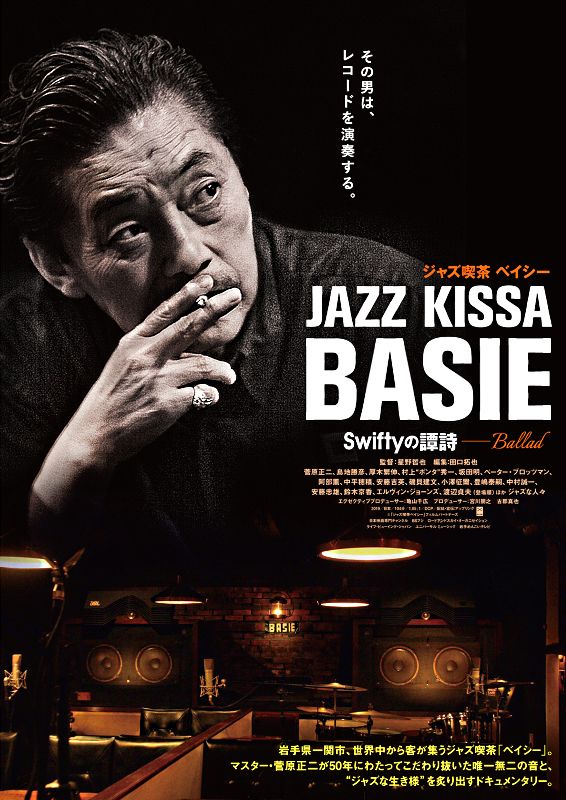
(© Jazz Kissa Basie Film Partners)
The film Jazu kissa Beishī: Swifty no tanshi (Jazz Café Basie: The Ballad of Swifty)
- Directed by Hoshino Tetsuya
- Starring Sugawara Shōji, Sakata Akira, Peter Brötzmann, Ozawa Seiji, Andō Tadao, Elvis Jones, Watanabe Sadao, and others
- Edited by Taguchi Takuya
- Release date: 2019
- Running time: 104 minutes
- Distributed by Up Link
- https://www.uplink.co.jp/Basie/ (Japanese)
(Originally written in Japanese by Matsumoto Takuya, Nippon.com. Banner photo: Sugawara Shōji at Jazz Kissa Basie. All photos © Hanai Tomoko except where otherwise indicated.)
